Hao Tian
Sichuan University
MiMo: Unlocking the Reasoning Potential of Language Model -- From Pretraining to Posttraining
May 12, 2025Abstract:We present MiMo-7B, a large language model born for reasoning tasks, with optimization across both pre-training and post-training stages. During pre-training, we enhance the data preprocessing pipeline and employ a three-stage data mixing strategy to strengthen the base model's reasoning potential. MiMo-7B-Base is pre-trained on 25 trillion tokens, with additional Multi-Token Prediction objective for enhanced performance and accelerated inference speed. During post-training, we curate a dataset of 130K verifiable mathematics and programming problems for reinforcement learning, integrating a test-difficulty-driven code-reward scheme to alleviate sparse-reward issues and employing strategic data resampling to stabilize training. Extensive evaluations show that MiMo-7B-Base possesses exceptional reasoning potential, outperforming even much larger 32B models. The final RL-tuned model, MiMo-7B-RL, achieves superior performance on mathematics, code and general reasoning tasks, surpassing the performance of OpenAI o1-mini. The model checkpoints are available at https://github.com/xiaomimimo/MiMo.
EfficientHuman: Efficient Training and Reconstruction of Moving Human using Articulated 2D Gaussian
Apr 29, 2025Abstract:3D Gaussian Splatting (3DGS) has been recognized as a pioneering technique in scene reconstruction and novel view synthesis. Recent work on reconstructing the 3D human body using 3DGS attempts to leverage prior information on human pose to enhance rendering quality and improve training speed. However, it struggles to effectively fit dynamic surface planes due to multi-view inconsistency and redundant Gaussians. This inconsistency arises because Gaussian ellipsoids cannot accurately represent the surfaces of dynamic objects, which hinders the rapid reconstruction of the dynamic human body. Meanwhile, the prevalence of redundant Gaussians means that the training time of these works is still not ideal for quickly fitting a dynamic human body. To address these, we propose EfficientHuman, a model that quickly accomplishes the dynamic reconstruction of the human body using Articulated 2D Gaussian while ensuring high rendering quality. The key innovation involves encoding Gaussian splats as Articulated 2D Gaussian surfels in canonical space and then transforming them to pose space via Linear Blend Skinning (LBS) to achieve efficient pose transformations. Unlike 3D Gaussians, Articulated 2D Gaussian surfels can quickly conform to the dynamic human body while ensuring view-consistent geometries. Additionally, we introduce a pose calibration module and an LBS optimization module to achieve precise fitting of dynamic human poses, enhancing the model's performance. Extensive experiments on the ZJU-MoCap dataset demonstrate that EfficientHuman achieves rapid 3D dynamic human reconstruction in less than a minute on average, which is 20 seconds faster than the current state-of-the-art method, while also reducing the number of redundant Gaussians.
InternVL3: Exploring Advanced Training and Test-Time Recipes for Open-Source Multimodal Models
Apr 15, 2025Abstract:We introduce InternVL3, a significant advancement in the InternVL series featuring a native multimodal pre-training paradigm. Rather than adapting a text-only large language model (LLM) into a multimodal large language model (MLLM) that supports visual inputs, InternVL3 jointly acquires multimodal and linguistic capabilities from both diverse multimodal data and pure-text corpora during a single pre-training stage. This unified training paradigm effectively addresses the complexities and alignment challenges commonly encountered in conventional post-hoc training pipelines for MLLMs. To further improve performance and scalability, InternVL3 incorporates variable visual position encoding (V2PE) to support extended multimodal contexts, employs advanced post-training techniques such as supervised fine-tuning (SFT) and mixed preference optimization (MPO), and adopts test-time scaling strategies alongside an optimized training infrastructure. Extensive empirical evaluations demonstrate that InternVL3 delivers superior performance across a wide range of multi-modal tasks. In particular, InternVL3-78B achieves a score of 72.2 on the MMMU benchmark, setting a new state-of-the-art among open-source MLLMs. Its capabilities remain highly competitive with leading proprietary models, including ChatGPT-4o, Claude 3.5 Sonnet, and Gemini 2.5 Pro, while also maintaining strong pure-language proficiency. In pursuit of open-science principles, we will publicly release both the training data and model weights to foster further research and development in next-generation MLLMs.
GoT: Unleashing Reasoning Capability of Multimodal Large Language Model for Visual Generation and Editing
Mar 13, 2025Abstract:Current image generation and editing methods primarily process textual prompts as direct inputs without reasoning about visual composition and explicit operations. We present Generation Chain-of-Thought (GoT), a novel paradigm that enables generation and editing through an explicit language reasoning process before outputting images. This approach transforms conventional text-to-image generation and editing into a reasoning-guided framework that analyzes semantic relationships and spatial arrangements. We define the formulation of GoT and construct large-scale GoT datasets containing over 9M samples with detailed reasoning chains capturing semantic-spatial relationships. To leverage the advantages of GoT, we implement a unified framework that integrates Qwen2.5-VL for reasoning chain generation with an end-to-end diffusion model enhanced by our novel Semantic-Spatial Guidance Module. Experiments show our GoT framework achieves excellent performance on both generation and editing tasks, with significant improvements over baselines. Additionally, our approach enables interactive visual generation, allowing users to explicitly modify reasoning steps for precise image adjustments. GoT pioneers a new direction for reasoning-driven visual generation and editing, producing images that better align with human intent. To facilitate future research, we make our datasets, code, and pretrained models publicly available at https://github.com/rongyaofang/GoT.
PVC: Progressive Visual Token Compression for Unified Image and Video Processing in Large Vision-Language Models
Dec 12, 2024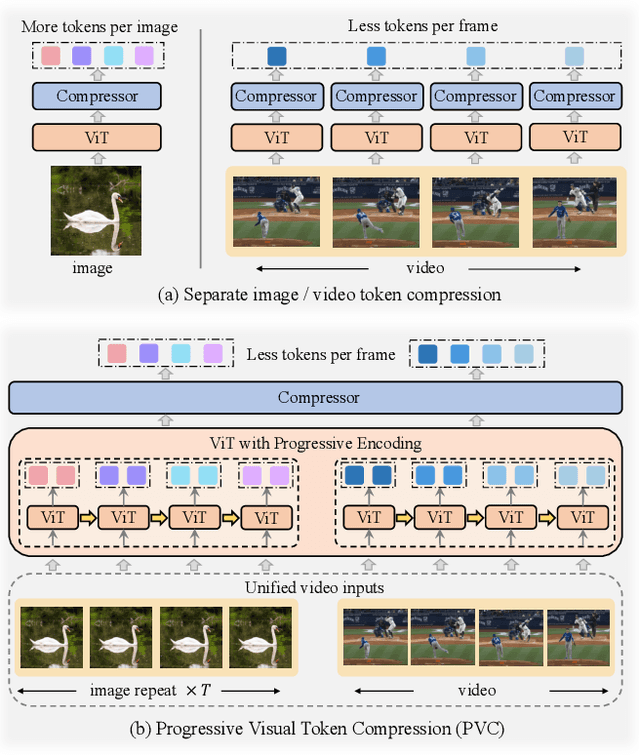
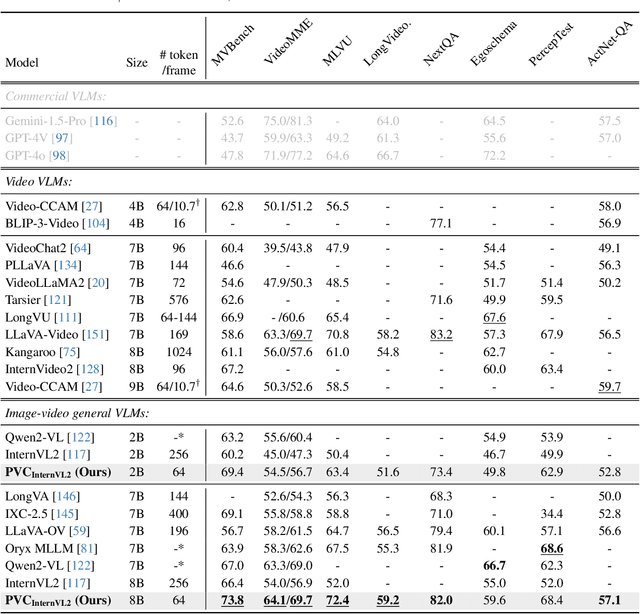
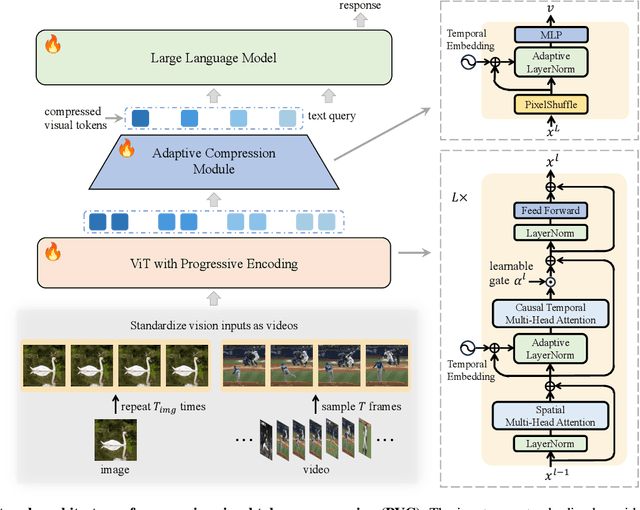
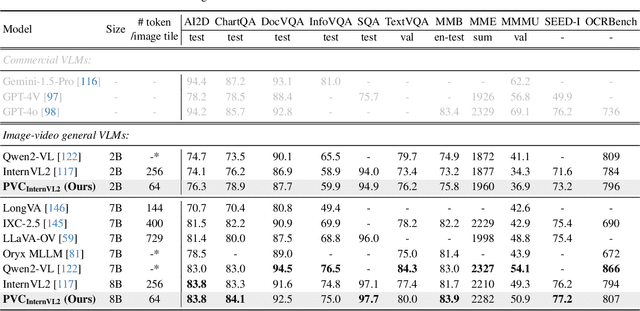
Abstract:Large Vision-Language Models (VLMs) have been extended to understand both images and videos. Visual token compression is leveraged to reduce the considerable token length of visual inputs. To meet the needs of different tasks, existing high-performance models usually process images and videos separately with different token compression strategies, limiting the capabilities of combining images and videos. To this end, we extend each image into a "static" video and introduce a unified token compression strategy called Progressive Visual Token Compression (PVC), where the tokens of each frame are progressively encoded and adaptively compressed to supplement the information not extracted from previous frames. Video tokens are efficiently compressed with exploiting the inherent temporal redundancy. Images are repeated as static videos, and the spatial details can be gradually supplemented in multiple frames. PVC unifies the token compressing of images and videos. With a limited number of tokens per frame (64 tokens by default), spatial details and temporal changes can still be preserved. Experiments show that our model achieves state-of-the-art performance across various video understanding benchmarks, including long video tasks and fine-grained short video tasks. Meanwhile, our unified token compression strategy incurs no performance loss on image benchmarks, particularly in detail-sensitive tasks.
Expanding Performance Boundaries of Open-Source Multimodal Models with Model, Data, and Test-Time Scaling
Dec 06, 2024



Abstract:We introduce InternVL 2.5, an advanced multimodal large language model (MLLM) series that builds upon InternVL 2.0, maintaining its core model architecture while introducing significant enhancements in training and testing strategies as well as data quality. In this work, we delve into the relationship between model scaling and performance, systematically exploring the performance trends in vision encoders, language models, dataset sizes, and test-time configurations. Through extensive evaluations on a wide range of benchmarks, including multi-discipline reasoning, document understanding, multi-image / video understanding, real-world comprehension, multimodal hallucination detection, visual grounding, multilingual capabilities, and pure language processing, InternVL 2.5 exhibits competitive performance, rivaling leading commercial models such as GPT-4o and Claude-3.5-Sonnet. Notably, our model is the first open-source MLLMs to surpass 70% on the MMMU benchmark, achieving a 3.7-point improvement through Chain-of-Thought (CoT) reasoning and showcasing strong potential for test-time scaling. We hope this model contributes to the open-source community by setting new standards for developing and applying multimodal AI systems. HuggingFace demo see https://huggingface.co/spaces/OpenGVLab/InternVL
Mini-InternVL: A Flexible-Transfer Pocket Multimodal Model with 5% Parameters and 90% Performance
Oct 21, 2024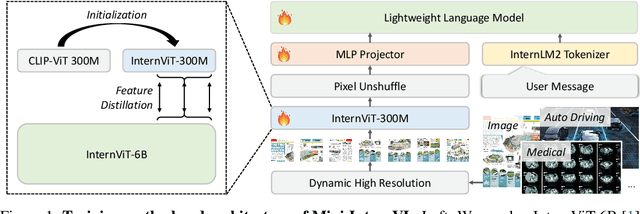
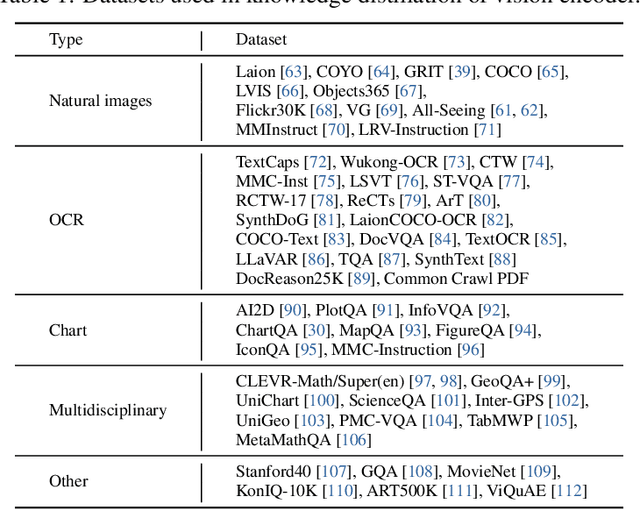
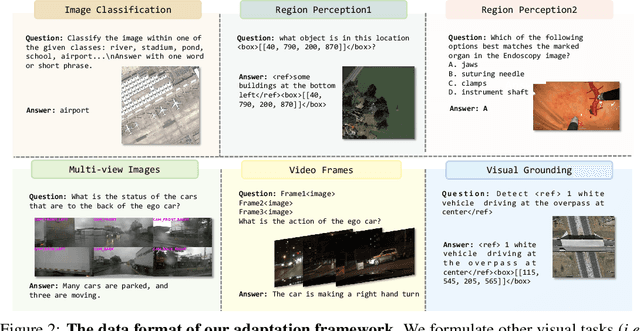
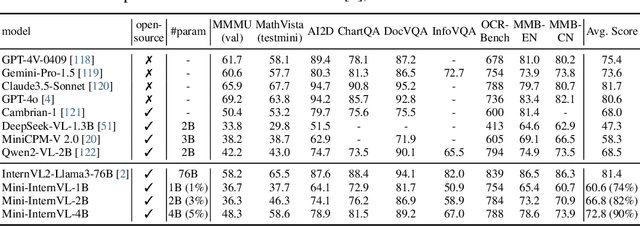
Abstract:Multimodal large language models (MLLMs) have demonstrated impressive performance in vision-language tasks across a broad spectrum of domains. However, the large model scale and associated high computational costs pose significant challenges for training and deploying MLLMs on consumer-grade GPUs or edge devices, thereby hindering their widespread application. In this work, we introduce Mini-InternVL, a series of MLLMs with parameters ranging from 1B to 4B, which achieves 90% of the performance with only 5% of the parameters. This significant improvement in efficiency and effectiveness makes our models more accessible and applicable in various real-world scenarios. To further promote the adoption of our models, we develop a unified adaptation framework for Mini-InternVL, which enables our models to transfer and outperform specialized models in downstream tasks, including autonomous driving, medical images, and remote sensing. We believe that our study can provide valuable insights and resources to advance the development of efficient and effective MLLMs. Code is available at https://github.com/OpenGVLab/InternVL.
PUMA: Empowering Unified MLLM with Multi-granular Visual Generation
Oct 17, 2024



Abstract:Recent advancements in multimodal foundation models have yielded significant progress in vision-language understanding. Initial attempts have also explored the potential of multimodal large language models (MLLMs) for visual content generation. However, existing works have insufficiently addressed the varying granularity demands of different image generation tasks within a unified MLLM paradigm - from the diversity required in text-to-image generation to the precise controllability needed in image manipulation. In this work, we propose PUMA, emPowering Unified MLLM with Multi-grAnular visual generation. PUMA unifies multi-granular visual features as both inputs and outputs of MLLMs, elegantly addressing the different granularity requirements of various image generation tasks within a unified MLLM framework. Following multimodal pretraining and task-specific instruction tuning, PUMA demonstrates proficiency in a wide range of multimodal tasks. This work represents a significant step towards a truly unified MLLM capable of adapting to the granularity demands of various visual tasks. The code and model will be released in https://github.com/rongyaofang/PUMA.
MMIU: Multimodal Multi-image Understanding for Evaluating Large Vision-Language Models
Aug 05, 2024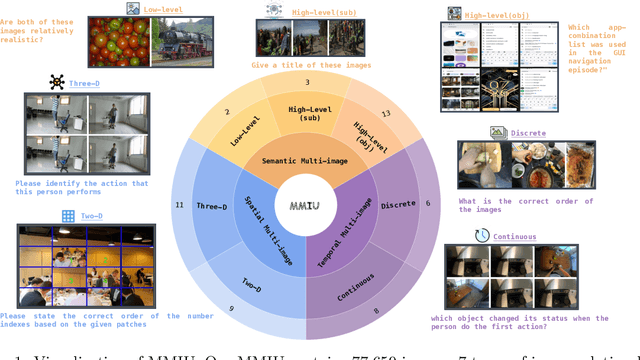

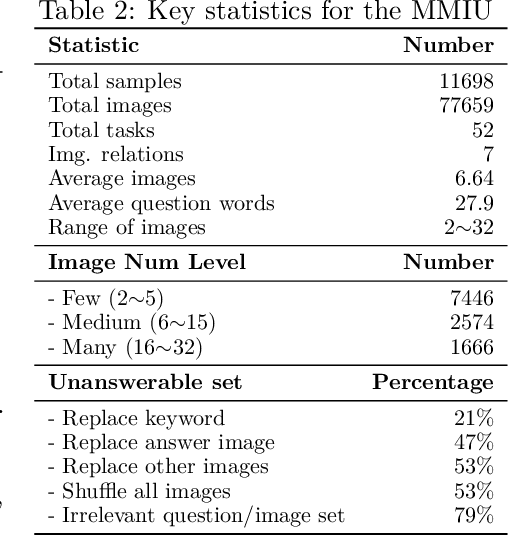
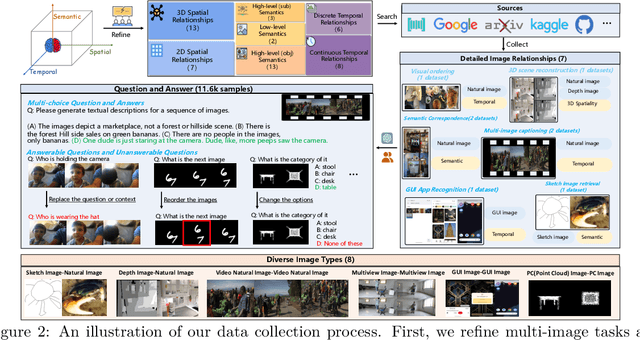
Abstract:The capability to process multiple images is crucial for Large Vision-Language Models (LVLMs) to develop a more thorough and nuanced understanding of a scene. Recent multi-image LVLMs have begun to address this need. However, their evaluation has not kept pace with their development. To fill this gap, we introduce the Multimodal Multi-image Understanding (MMIU) benchmark, a comprehensive evaluation suite designed to assess LVLMs across a wide range of multi-image tasks. MMIU encompasses 7 types of multi-image relationships, 52 tasks, 77K images, and 11K meticulously curated multiple-choice questions, making it the most extensive benchmark of its kind. Our evaluation of 24 popular LVLMs, including both open-source and proprietary models, reveals significant challenges in multi-image comprehension, particularly in tasks involving spatial understanding. Even the most advanced models, such as GPT-4o, achieve only 55.7% accuracy on MMIU. Through multi-faceted analytical experiments, we identify key performance gaps and limitations, providing valuable insights for future model and data improvements. We aim for MMIU to advance the frontier of LVLM research and development, moving us toward achieving sophisticated multimodal multi-image user interactions.
MMInstruct: A High-Quality Multi-Modal Instruction Tuning Dataset with Extensive Diversity
Jul 22, 2024



Abstract:Despite the effectiveness of vision-language supervised fine-tuning in enhancing the performance of Vision Large Language Models (VLLMs). However, existing visual instruction tuning datasets include the following limitations: (1) Instruction annotation quality: despite existing VLLMs exhibiting strong performance, instructions generated by those advanced VLLMs may still suffer from inaccuracies, such as hallucinations. (2) Instructions and image diversity: the limited range of instruction types and the lack of diversity in image data may impact the model's ability to generate diversified and closer to real-world scenarios outputs. To address these challenges, we construct a high-quality, diverse visual instruction tuning dataset MMInstruct, which consists of 973K instructions from 24 domains. There are four instruction types: Judgement, Multiple-Choice, Long Visual Question Answering and Short Visual Question Answering. To construct MMInstruct, we propose an instruction generation data engine that leverages GPT-4V, GPT-3.5, and manual correction. Our instruction generation engine enables semi-automatic, low-cost, and multi-domain instruction generation at 1/6 the cost of manual construction. Through extensive experiment validation and ablation experiments, we demonstrate that MMInstruct could significantly improve the performance of VLLMs, e.g., the model fine-tuning on MMInstruct achieves new state-of-the-art performance on 10 out of 12 benchmarks. The code and data shall be available at https://github.com/yuecao0119/MMInstruct.
 Add to Chrome
Add to Chrome Add to Firefox
Add to Firefox Add to Edge
Add to Edge